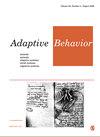Smooth coping: an embodied, Heideggerian approach to dual-process theory
IF 1.3
4区 计算机科学
Q4 COMPUTER SCIENCE, ARTIFICIAL INTELLIGENCE
引用次数: 4
Abstract
Dual-process theories divide cognition into two kinds of processes: Type 1 processes that are autonomous and do not use working memory, and Type 2 processes that are decoupled from the immediate situation and use working memory. Often, Type 1 processes are also fast, high capacity, parallel, nonconscious, biased, contextualized, and associative, while Type 2 processes are typically slow, low capacity, serial, conscious, normative, abstract, and rule-based. This article argues for an embodied dual-process theory based on the phenomenology of Martin Heidegger. According to Heidegger, the basis of human agents’ encounters with the world is in a prereflective, pragmatically engaged disposition marked by readiness-to-hand (Zuhandenheit), sometimes equated with “smooth coping.” Examples of smooth coping include walking, throwing a ball, and other embodied actions that do not require reflective thought. I argue that smooth coping primarily consists of Type 1 processes. The Heideggerian dual-process model yields distinctly different hypotheses from Hubert Dreyfus’ model of smooth coping, and I will critically engage with Dreyfus’ work.平稳应对:对双重过程理论的一种具体化的、海德格尔的方法
双重过程理论将认知分为两类过程:第一类过程是自主的,不使用工作记忆;第二类过程是与即时情况脱钩,使用工作记忆。通常,类型1的过程也是快速、高容量、并行、无意识、有偏见、情境化和关联的,而类型2的过程通常是缓慢、低容量、串行、有意识、规范、抽象和基于规则的。本文在海德格尔现象学的基础上,提出了一种具体化的双重过程理论。根据海德格尔的说法,人类主体与世界相遇的基础是一种预先反射的、务实的倾向,其特点是随时准备出手(Zuhandenheit),有时等同于“平稳应对”。平稳应对的例子包括走路、投球和其他不需要反思的具体行动。我认为,平稳应对主要包括第一类过程。海德格的双重过程模型产生了与休伯特-德雷福斯的平稳应对模型截然不同的假设,我将批判性地参与德雷福斯的工作。
本文章由计算机程序翻译,如有差异,请以英文原文为准。
求助全文
约1分钟内获得全文
求助全文
来源期刊

Adaptive Behavior
工程技术-计算机:人工智能
CiteScore
4.30
自引率
18.80%
发文量
34
审稿时长
>12 weeks
期刊介绍:
_Adaptive Behavior_ publishes articles on adaptive behaviour in living organisms and autonomous artificial systems. The official journal of the _International Society of Adaptive Behavior_, _Adaptive Behavior_, addresses topics such as perception and motor control, embodied cognition, learning and evolution, neural mechanisms, artificial intelligence, behavioral sequences, motivation and emotion, characterization of environments, decision making, collective and social behavior, navigation, foraging, communication and signalling.
Print ISSN: 1059-7123
 求助内容:
求助内容: 应助结果提醒方式:
应助结果提醒方式:


